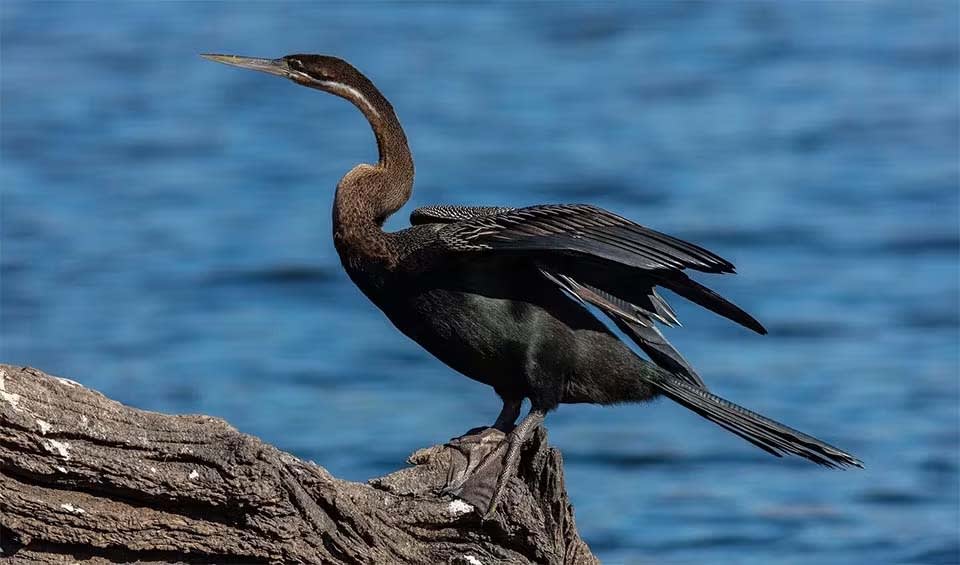This bird is well-adapted to a semi-aquatic lifestyle and is commonly found across Sub-Saharan Africa, inhabiting a variety of freshwater environments, including lakes, swamps, and rivers. The bird has a very slim and long neck, which has earned it the nickname “snakebird,” as only the neck appears above water when it swims, resembling a snake ready to strike.
The African darter’s primary diet consists of fish, which it hunts with remarkable skill. Its body is specially adapted for an aquatic hunting lifestyle; it has webbed feet for propulsion and a long, sharp bill for spearing fish underwater. When hunting, the darter submerges itself and can swim long distances underwater to approach its prey stealthily. Once it spots a target, it uses its powerful neck and bill to spear the fish with precision.
One of the most intriguing aspects of the African darter is its feather structure. Unlike many other waterfowl, the darter’s feathers do not have waterproof oils, which allows it to decrease buoyancy and dive deeper and with more agility. However, this adaptation comes with the downside of the feathers becoming waterlogged. Consequently, the African darter is often seen perched with its wings spread out to dry in the sun after a hunting session. This behavior is critical for maintaining the bird’s body temperature and flight capabilities.
The drying of feathers is a critical behavior and is often a communal activity, with large groups of darters seen basking together along the banks of rivers or lakes. This behavior facilitates drying and serves as a social interaction among the birds.
Distribution
 Angola
Angola Benin
Benin Botswana
Botswana Burkina Faso
Burkina Faso Burundi
Burundi Cameroon
Cameroon Central Af. Rep.
Central Af. Rep. Chad
Chad Comoros
Comoros Congo-Brazzaville
Congo-Brazzaville Côte D’ivoire
Côte D’ivoire DR Congo (Kinshasa)
DR Congo (Kinshasa) Egypt
Egypt Equatorial Guinea
Equatorial Guinea Eritrea
Eritrea Eswatini
Eswatini Ethiopia
Ethiopia Gabon
Gabon Gambia
Gambia Ghana
Ghana Guinea-Bissau
Guinea-Bissau Guinea
Guinea Iran
Iran Iraq
Iraq Israel
Israel Official estimate
Official estimate
 Jordan
Jordan Official estimate
Official estimate
 Kenya
Kenya Lesotho
Lesotho Liberia
Liberia Madagascar
Madagascar Malawi
Malawi Mali
Mali Mauritania
Mauritania Mozambique
Mozambique Namibia
Namibia Niger
Niger Nigeria
Nigeria Rwanda
Rwanda Senegal
Senegal Sierra Leone
Sierra Leone Somalia
Somalia South Africa
South Africa South Sudan
South Sudan Sudan
Sudan Syria
Syria Official estimate
Official estimate
 Tanzania
Tanzania Turkey
Turkey Official estimate
Official estimate
 Uganda
Uganda Yemen
Yemen Zambia
Zambia Zimbabwe
ZimbabweAnything we've missed?
Help us improve this page by suggesting edits. Glory never dies!
Suggest an editGet to know me
Terrestrial / Aquatic
Altricial / Precocial
Polygamous / Monogamous
Dimorphic (size) / Monomorphic
Active: Diurnal / Nocturnal
Social behavior: Solitary / Pack / Herd / Flock
Diet: Carnivore / Herbivore / Omnivore / Piscivorous / Insectivore
Migratory: Yes / No
Domesticated: Yes / No
Dangerous: Yes / No




